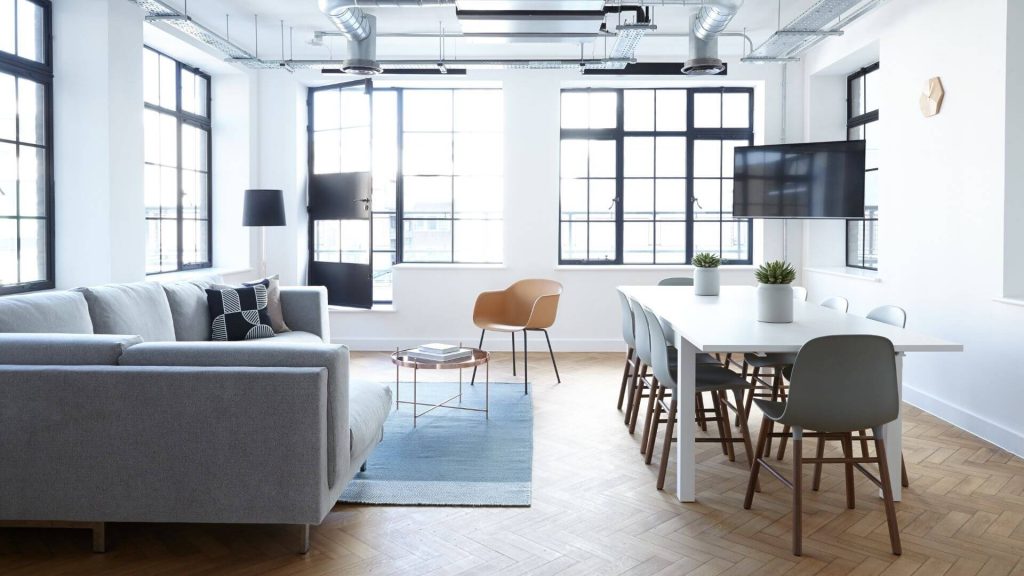Table Of Contents
Designing a small office fit-out can feel like solving a puzzle. Small spaces face unique challenges. Yet, with the right methods, tiny offices can be functional, efficient, and inspiring. Today, hybrid work and flexible layouts are common. Thus, it’s vital to maximise small spaces.
A good small office fit-out goes beyond adding furniture. It creates a space that boosts productivity, ensures comfort, and reflects the brand. Now, with clever storage and versatile furniture, it’s easier than ever to maximise small offices. It’s also more innovative.
In this guide, we’ll explore the challenges of small office fit-outs and provide space-saving solutions that focus on boosting productivity. Whether you’re working with a modest budget or looking for high-end customisation, this article will offer practical tips to help you design a small office that works big.
Understanding the Challenges of Small Office Fit-Outs
Fitting out a small office can be a tricky task. Limited space means every design choice must be carefully thought through to make the most of what’s available. From selecting the right furniture to finding creative ways to store supplies, the challenges of working in a compact office space can feel overwhelming. However, with the right approach, these obstacles can turn into opportunities.
Making the Most of Limited Space
The main challenge of a small office fit-out is maximising the use of every square metre. In tight spaces, there’s little room for wasted areas. You may need to think outside the box, like transforming a corner into a breakout zone or using under-desk storage to keep workstations clutter-free. Multi-functional spaces are key—for instance, a meeting room that doubles as a quiet work zone or even a relaxation area when needed.
Finding the Balance Between Style and Function
It’s easy for small offices to feel cramped or overly utilitarian. Bulky furniture, dark colours, or overly complex layouts can make the space feel even smaller. On the other hand, focusing only on functionality might result in a space that feels cold or uninspiring. Achieving the right balance between practicality and style is essential. Small design touches—like a splash of colour, plants, or smart lighting—can make a big difference without overwhelming the space.
Budgeting Wisely in a Small Office
Cost is another major factor in small office fit-outs. While smaller spaces might mean fewer materials, the cost of clever solutions—like custom storage or adaptable furniture—can add up. It’s tempting to cut corners, but skimping on quality often results in higher costs later when items need replacing. Investing in durable, space-efficient designs is often worth the initial expense.

By addressing these challenges with creativity and careful planning, small offices can become highly functional and enjoyable workspaces. The key is to think strategically, stay flexible, and approach the process with an open mind.
Space-Saving Solutions for Small Offices
The smart design transforms tiny offices into productive havens. Limited space demands creativity and practicality. Focus on comfort and clever choices to maximise every nook. A thoughtful approach turns challenges into opportunities. It creates stylish, high-performing workspaces.
Multi-Functional Furniture
Maximise space with multifunctional furnishings. Desks with storage, collapsible tables, and dual-purpose ottomans are ideal for this task. Modular pieces adapt easily, accommodating team huddles or solo work. Choose sleek, lightweight designs to maintain an open atmosphere. These versatile choices keep your space clutter-free and efficient, meeting diverse needs without making it feel cramped.
Clever Storage Options
In a small office, every bit of storage matters. Instead of bulky filing cabinets, opt for wall-mounted shelves, under-desk drawers, or even vertical units that make use of unused wall space. Hidden storage, like benches with compartments or pull-out shelving, is a simple way to keep things tidy without cluttering the office. Pegboards or magnetic organisers can be used for supplies you need close at hand, leaving desk surfaces free for work.
Layout That Works
A well-thought-out layout is key to making a small office functional. Position desks and workstations near windows to take advantage of natural light and create an inviting atmosphere. Avoid cramming too much into one space—open areas improve the flow and make the office feel less cramped. For zones that need separation, lightweight dividers or low bookcases can create structure without cutting off the room completely.
Vertical Thinking
When you’re short on floor space, look upwards. Tall bookshelves, wall hooks, or hanging organisers can add storage without taking up room on the ground. Vertical design doesn’t just save space—it can add style, too. Hanging plants or wall art can bring personality to the office while keeping the footprint minimal.
Flexible Work Areas
In compact workspaces, versatility is paramount. A well-designed space easily transforms to meet diverse needs. Picture a single table serving multiple purposes: hosting meetings, fostering teamwork, and becoming a lunchtime gathering spot. With mobile, lightweight furnishings, you can quickly reconfigure the space to suit each task. This adaptable approach ensures your office space is used to its full potential, with every square metre contributing to productivity.

A small office can seem larger with smart design, versatile features, and a focus on practicality. Consider how each element meets your needs. Aim for solutions that improve both function and style.
Cost-Effective Fit-Out Tips for Small Offices
Designing a small office on a budget doesn’t mean you have to settle for less. In fact, with a bit of smart planning and some creative thinking, you can create a workspace that feels professional, stylish, and practical—all while staying within your financial limits. Here’s how to make your fit-out work for you without stretching your budget too far:
Refresh Instead of Replace
Before you rush to buy new furniture, take a moment to consider what you already have. An old desk might just need sanding and a fresh coat of paint to feel brand new. Filing cabinets or shelving units can be updated with sleek new handles or a touch of modern colour. By refreshing instead of replacing, you’ll save money and add a unique character to your office.
Think Function Over Flash
When choosing furniture, it’s easy to get caught up in trendy designs, but practicality should always come first—especially in a small space. Look for furniture that’s multi-purpose, like a table that doubles as a storage unit or chairs that can stack away neatly when not in use. You’ll get more value for your money and keep the space feeling open and uncluttered.
Plan for the Long Term
Sometimes, spending a little extra now can save you a lot in the future. Energy-efficient lighting, like LEDs, might cost more upfront, but they’ll reduce your utility bills over time. The same goes for smart thermostats or appliances. These investments not only make your office greener but also keep your monthly running costs down.

Add Personality Without Adding Costs
Personal touches don’t need to come with a big price tag. A few carefully chosen plants can do wonders for the atmosphere, adding life and colour to the space. DIY artwork or framed photos can give your office a welcoming, creative vibe without breaking the bank. Sometimes, the smallest details make the biggest impact.
Avoid Last-Minute Surprises
Planning is your best friend when you’re working with a tight budget. List everything you’ll need—furniture, tools, paint—and stick to your plan. It’s also wise to set aside a small portion of your budget for unexpected expenses. That way, if something comes up, you’re prepared, and your project stays on track.
Know When to Call in the Experts
While DIY is great for some parts of a fit-out, there are areas where professional help can actually save you money in the long run. Tasks like electrical work or custom installations should always be handled by experts to avoid costly mistakes. A professional’s touch can also add polish to your space, helping you achieve a result that looks like you spent more than you actually did.
Creating a small office that’s both stylish and functional doesn’t have to cost a fortune. With thoughtful planning, a little creativity, and smart choices, you can design a workspace that feels bigger than it is—and reflects your brand and vision perfectly.
Working with Professionals for Small Office Fit-Outs
Creating a small office is both rewarding and challenging. It requires managing space and staying within budget. Many factors are involved. Here, professionals can help. They enhance the office’s look and ensure a smooth process.
Turning Constraints into Opportunities
A professional designer sees possibilities where most of us see problems. Do you have an awkward corner? They’ll find a way to make it functional. Limited floor space? They’ll show you how to think vertically. A professional brings a fresh perspective, turning constraints into creative opportunities. They’re not just focused on making your office look good; they’ll make it work for you in ways you hadn’t imagined.
Additionally, they will customise their solutions for you. Whether you need a space for brainstorming or a quiet area for focus, a skilled fit-out expert will design your office with intention.
Simplifying the Stress of Fit-Outs
Fit-outs can be tough. You have to manage contractors, find materials, stick to schedules, and stay on budget—all while running your business. This can lead to burnout. Professionals can help. They handle everything, ensuring a smooth process.
Their expertise reduces mistakes, delays, and stress. They know what to avoid and save you money. With them in charge, you can focus on your business. They create the ideal workspace.
Access to Better Resources and Ideas
One of the biggest advantages of working with fit-out specialists is their access to resources. They have industry connections that can open doors to better-quality materials, skilled contractors, and innovative design ideas—all within your budget. You won’t waste time hunting for the right furniture or worrying about whether a contractor will deliver. Instead, you’ll benefit from their trusted network and insider knowledge.

And let’s not forget the power of experience. Professionals bring with them a deep understanding of what works—and what doesn’t. They can guide you towards smart decisions that you might not have considered, whether it’s selecting multi-functional furniture or incorporating energy-efficient systems to cut long-term costs.
A Professional Touch That Stands Out
There’s a reason professionally designed spaces stand out. It’s the subtle details—the seamless finishes, the thoughtful layouts, the way everything just feels “right.” That level of polish can be hard to achieve on your own, especially in a small office where every design choice matters.
When you work with a professional, you’re not just investing in a fit-out. You’re investing in an environment that reflects your brand, inspires your team, and leaves a lasting impression on clients. It’s not just about what your office looks like—it’s about how it makes people feel.
Why SEI is Your Partner for Small Office Fit-Outs
Designing a small office is tough. Yet, with the right strategy and partner, it can foster creativity and productivity. At SEI, we craft personalised solutions for small office layouts. Our goal is to help businesses optimise their space without sacrificing style or functionality.
Our team is skilled at turning small spaces into efficient, multi-functional areas that meet your needs. We use smart storage, custom layouts, and sustainable designs to achieve this. Our main focus is on getting results that benefit your business. Every decision we make aligns with your goals, ensuring the design is practical and reflects your brand.
SEI brings more than just design expertise to the table—we bring a commitment to quality and attention to detail that ensures your fit-out is completed on time and within budget. From concept to completion, we’re here to manage the process, solve challenges, and create a workspace that supports your team and your vision.
Partnering with SEI means more than just a finished office—it means having a space that feels like an investment in your business’s future. Let us help you turn your small office into a place where big ideas thrive.



